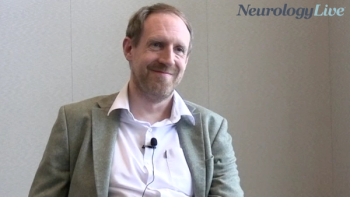
American Headache Society Calls for CGRP Medications to be Considered as First-Line Migraine Preventive Treatments
The new position statement proposes the use of CGRP-targeting therapies to be used as first-line treatments, eliminating the need to fail multiple medications before access.
For the first time ever, the American Headache Society (AHS) is calling for calcitonin gene-related peptide (CGRP)-targeting therapies to be used as a first-line approach for migraine prevention. Following a comprehensive review of clinical trial and real-world experience, a recently published statement from the organization claimed that CGRP-targeting therapies have "rapidly become an indispensable option for the prevention of migraine."1,2
Over the years, the toolbox of CGRP-targeting preventive treatment options for migraine has expanded significantly. These include monoclonal antibodies like erenumab, framanezumab, galcanezumab, and eptinezumab, and small-molecule CGRP receptor antagonists (gepants) such as rimegepant and atogepant. Prior to the newly published statement, the previous AHS consensus statements claimed that an individual try at least 2 classes of previous first-line migraine medications for at least 8 weeks before being considered for CGRP-targeting therapy.
The focused AHS position statement was based on several reasoning factors, including the mounting evidence that establishes CGRP as a fundamental mechanism of migraine and CGRP-targeting therapies as “migraine-specific.” In addition, the cumulative evidence for the efficacy, safety, and tolerability of these agents is significantly greater than that for any established migraine preventive therapy. CGRP-targeting therapies also have a greater evidence base on categories of responder rates, efficacy in patients with multiple prior treatment failures, efficacy in those with acute medication overuse, and those who do and do not have aura.
"Moving CGRP-targeting therapies to the first line of treatment could have a transformational impact on the prevention of migraine attacks and their associated burdens," co-author Andrew Charles, MD, FAHS, president of the AHS, said in a statement. "Elevating CGRP-targeting therapies to the first line should reduce barriers for patients to receive these effective treatments and bring hope to countless people who experience this invisible, yet debilitating disease."
Another reason for the paper was that nearly all CRGP-targeting therapies are FDA-approved for the preventive treatment of both episodic and chronic migraine, which may simplify decision-making in patients who simultaneously transition back and forth along the continuum of episodic and chronic migraine. Rimegepant remains only approved for episodic migraine prevention because its pivotal prevention study excluded those with more than 18 monthly headache days.
READ MORE:
Since their introduction in 2018, there have been several different real-world studies further assessing the efficacy and safety of CGRP-targeting agents. Although the evidence from these studies is not considered to be of the same quality as randomized controlled trials, these analyses have generally confirmed the results of RCTs regarding efficacy, tolerability, and safety. Safety concerns with these therapies identified in real-world studies include constipation and hypertension and Raynauds phenomenon; however, these are mostly uncommon and don’t necessitate discontinuation of therapy.
Cost considerations were also another major reason for the position statement. While the AHS did not justify the cost of GCRP-targeting preventive therapies, the organization did argue that it is critically important to consider not only the direct cost of the treatment, but also the substantial costs to the individual and society if effective treatment is delayed. In some instances, CGRP-targeting preventive therapies have reduced acute medication use, which may represent a significant cost savings. Similar evidence does not exist for previous first-line preventive therapies.
"It is clear that if cost were not a primary consideration, there would be no controversy regarding the legitimate place for CGRP-targeting therapies as a first-line option for migraine prevention given their established safety, efficacy, and years of integration into practice," Charles et al wrote. "While some head-to-head evidence and substantial ‘real-world’ experience indicates that CGRP-targeting therapies may be a superior option for a significant number of patients, further evidence and experience are needed to conclude that CGRP-targeting therapies are the first-line therapy, as opposed to a first-line therapy option, as is the position of this updated consensus statement from the AHS."
The HER-MES study (NCT03828539) remains the only head-to-head study demonstrating the superiority of a CGRP-targeting therapy over an established migraine preventive therapy. Published in 2022, results showed that significantly more patients on erenumab had at least a 50% reduction in monthly migraine days over a 3-month period compared with those on topiramate (55.4% vs 31.2%; OR, 2.76; 95% CI, 2.06-3.71; P <.001). In addition, adherence to erenumab was significantly better than adherence to topiramate.3
REFERENCES
1. American Headache Society publishes updated guidance on migraine preventive therapy. American Headache Society. March 11, 2024. Accessed April 8, 2024. https://www.prnewswire.com/news-releases/american-headache-society-publishes-updated-guidance-on-migraine-preventive-therapy-302085761.html
2. Charles AC, Digre KB, Goadsby PJ, Robbins MS, Hershey A. Calcitonin gene-related peptide-targeting therapies are a first-line option for the prevention of migraine: an American Headache Society position statetment update. Headache. Published March 11, 2024. doi:10.1111/head.14692
3. Reuter U, Ehrlich M, Gendolla A, et al. Erenumab versus topiramate for the prevention of migraine – a randomized, double-blind, active-controlled phase 4 trial. Cephalagia. 2022;42(2):108-118. doi:10.1177/03331024211053571.
Newsletter
Keep your finger on the pulse of neurology—subscribe to NeurologyLive for expert interviews, new data, and breakthrough treatment updates.































